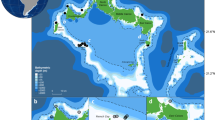Abstract
Seven pike Esox lucius L., implanted with radio-transmitters, were tracked throughout autumn and winter in the River Frome, a southern English chalk river. During the first flood events of the year, pike remained within the main river channel but during subsequent flood events, pike could also be found in flooded fields, in drainage ditches or in a millstream. Eighty percent of the fixes over flooded land occurred within 10 m of the riverbank, although distances of up to 89 m from the bank were recorded. In ditches, pike could be found over 250 m from the main river. For pike in ditches and flooded fields, distance from the main river channel was positively correlated with discharge. There was individual variation amongst pike for the habitat types selected, with some pike utilising flooded field or ditch habitat more often than others. The proportion of time spent out of the main river channel does not appear to be related to the size of the pike. It is hypothesised that pike are leaving the main river channel to exploit feeding opportunities in the flooded fields and drainage ditches, rather than using these areas as refugia from high flow conditions.
Similar content being viewed by others
References
Beaumont, W. R. C., B. Cresswell, K. H. Hodder, J. E. G. Masters & J. S. Welton, 2002. A simple activity monitoring radio tag for fish (this volume).
Billard, R., 1996. Reproduction of pike: gametogenesis, gamete biology and early development. In Craig, J. F. (ed.), Pike, Biology and Exploitation. Chapman and Hall, London: 13-43.
Boët, P., J. Belliard, R. Berrebi-dit-Thomas & E. Tales, 1999. Multiple human impacts by the City of Paris on fish communities in the Seine river basin, France. Hydrobiologia 410: 59-68.
Chapman, C. A. &W. C. Mackay, 1984. Versatility in habitat use by a top aquatic predator, Esox lucius L. J. Fish Biol. 25: 109-115.
Clough, S., 1998. Migration and habitat use of dace (Leuciscus leuciscus (L.)) in an English chalk stream. PhD Thesis. University of St. Andrews, Fife.
Crossman, E. J., 1996. Taxonomy and Distribution. In Craig, J. F. (ed.), Pike, Biology and Exploitation. Chapman and Hall, London: 1-11.
Jepsen, N., S. Beck, C. Skov & A. Koed, 2001. Behaviour of pike (Esox lucius L.) >50 cm in a turbid reservoir and in a clearwater lake. Ecol. Freshwat. Fish 10: 26-34.
Jones, D. R., J. W. Kiceniuk & O. S. Bamford, 1974. Evaluation of the swimming performance of several fish species from the Mackenzie River. J. Fish. Res. Bd Can. 31: 1641-1647.
Ladle, M. & D. F. Westlake, 1995. River and stream ecosystems of Great Britain. In Cushing C. E., K. W. Cummins & G. W. Minshall (eds), River and Stream Ecosystems. Elsevier, Amsterdam: 343-388.
Lamouroux, N., H. Capra, M. Pouilly & Y. Souchon, 1999. Fish habitat preferences in large streams of southern France. Freshwat. Biol. 42: 673-687.
Langford, T., 1979. Observations on sonic-tagged coarse fish in rivers. In Proceedings of the 1st British Freshwater Fisheries Conference, University of Liverpool, Liverpool: 106-114.
Maitland, P. S. & R. N. Campbell, 1992. Freshwater Fishes. Harper Collins Publishers, London: 368 pp.
Mann, R. H. K., 1976. Observations on the age, growth, reproduction and food of the pike Esox lucius (L.) in two rivers in southern England. J. Fish Biol. 8: 179-197.
Mann, R. H. K., 1980. The numbers and production of pike (Esox lucius) in two Dorset rivers. J. anim. Ecol. 49: 889-915.
Mann, R. H. K., 1982. The annual food consumption and prey preferences of pike (Esox lucius) in the River Frome, Dorset. J. anim. Ecol. 51: 81-95.
Raat, A. J. P., 1988. Synopsis of Biological Data on the Northern Pike Esox lucius Linnaeus, 1758. FAO Fisheries Synopsis No. 30 Rev. 2, Food and Agriculture Organisation of the United Nations, Rome: 178 pp.
Reimer, G., 1991. The ecological importance of floodplains for fish at the river March (Austria). Arch. Hydrobiol. 121(3): 355-363.
Ross, S. T. & J. A. Baker, 1983. The response of fishes to periodic spring floods in a southeastern stream. Am. Midl. Nat. 109 (1): 1-14.
Webb, P. W., 1984. Form and function in fish swimming. Scientific American 251: 58-68.
Wheeler, A., 1998. Fishes on Floodplains. In Bailey, R. G., P. V. José & B. R. Sherwood (eds), United Kingdom Floodplains.Westbury Academic & Scientific Publishing, Otley (West Yorkshire): 283-289.
Zar, J. H., 1974. Biostatistical Analysis. 3rd edn. Prentice-Hall Inc., New Jersey: 662 pp.
Author information
Authors and Affiliations
Corresponding author
Rights and permissions
About this article
Cite this article
Masters, J., Welton, J., Beaumont, W. et al. Habitat utilisation by pike Esox lucius L. during winter floods in a southern English chalk river. Hydrobiologia 483, 185–191 (2002). https://doi.org/10.1023/A:1021335713698
Issue Date:
DOI: https://doi.org/10.1023/A:1021335713698




